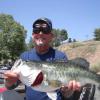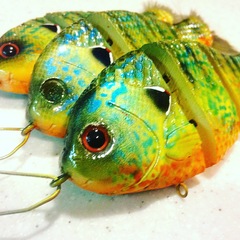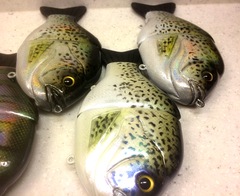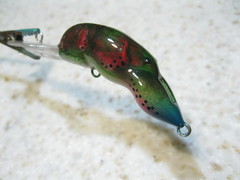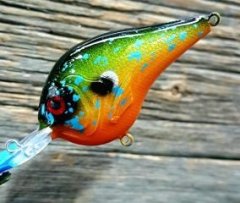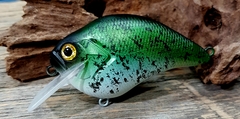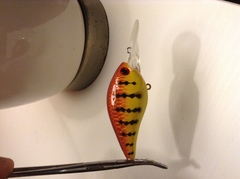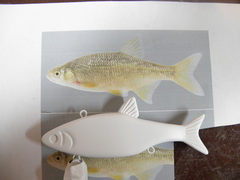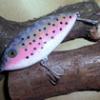Leaderboard
-
in all areas
- All areas
- Images
- Image Comments
- Image Reviews
- Albums
- Album Comments
- Album Reviews
- Topics
- Posts
- Stories
- Story Comments
- Story Reviews
- Classified Ads
- Classified Ad Comments
- Classified Ad Reviews
- Records
- Record Comments
- Record Reviews
- Websites
- Website Comments
- Website Reviews
- Status Updates
- Status Replies
-
Custom Date
-
All time
February 2 2011 - April 16 2024
-
Year
April 16 2023 - April 16 2024
-
Month
March 16 2024 - April 16 2024
-
Week
April 9 2024 - April 16 2024
-
Today
April 16 2024
-
Custom Date
04/23/2017 - 04/23/2017
-
All time
Popular Content
Showing content with the highest reputation on 04/23/2017 in all areas
-
Earlier this week I ordered some stuff from LPO, and got a call from them the next day to say that something I had ordered was out of stock, and asking what I wanted to do. I really appreciate the personalized service!3 points
-
You can make your own with feathers from a hobby store, any kind of thread, and a little finger nail polish. I use locking forceps held in my bench vise to hold the treble.2 points
-
I have decided to modify the largest cavity to accept my flat eye hooks. So I carefully drilled it out. I am getting a lot of flash and can't come up with anything to stop it. What do you think will work.1 point
-
1 point
-
1 point
-
Agreed. I've always had good experiences with LPO. Recently received an over-shipment from them. It was nothing of significance; I owed them another $5. But I had to call and let them know (couldn't in good conscience ignore it). Short version, they were appreciative I notified them, and said keep the extra items at no charge. Again, the situation was nothing big, but the call back, the 'thank you,' and the 'go ahead and keep them' goes a long way with me.1 point
-
That's kind of a loaded question as you will get a multitude of answers. Have you tried using the search function yet? Best thing to do is search some of your questions (best plastic, glitter, etc.) and that should answer many of your questions. Good luck, and welcome aboard!1 point
-
That was one hell of a read! My old mind is still looking for the translation button, but still......... Seriously, great stuff, and thanks for sharing!1 point
-
This was a good 10 years ago, and I'm still blown away by it. They kept saying, softer, softer, softer.......until the super soft did the trick. I guess they didn't mind paying a buck for a 4 inch swimbait when it netted them a nice fish. lol1 point
-
Every year a different set of colors will become popular so it is hard to predict. I remember a couple of years back when alimony came out, the first year it was tough to get.1 point
-
1 point
-
i am thinking a old component stereo cabinet would work great, with the glass door that is held by a magnet,, just pull the shelves out of it.1 point
-
I have an option on my page to sell sticks in 100 Ct bags. I was wondering where i could get bags similar or exact to what Gary (GYB Baits) uses for his 100 CT orders. See photo. Currently i use ziplocks. I have never had a complaint about it but I'm just looking for something thats a little more professional looking.1 point
-
1 point
-
Some blanks have spines in more than one direction, or secondary spines. Nonetheless, the latest pro advice is to build your rod so that the blank looks its straightest, regardless of what the spine may be. It really doesn't effect the performance of the rod one way or the other. But it is a little disconcerting to be casting a rod wth a well defined spine that is turned 90 degrees left or right.1 point
-
1 point
-
You bring up a good point Bob. The longer you use specific tools the more accomplished you become with them. Being familiar with the tools you use is a very important part of any builders skills. Ben1 point
-
I use a variable speed Foredom rotary tool with a soft rubber sanding cylinder and 220 grit paper to erase carving edges. But regardless I always resort to hand sanding with 220 or even 400 grit paper for final smoothing. A Dremel fine grit sanding cylinder does just as well as the Foredom if you apply a light touch. A rotary tool can get into areas that a disk or belt sander can't. I use my disk sander for milling blanks down to width and cutting initial tapers. I'm sure other tools will work as well. These are just the ones I had on hand when I started making baits, and I've stuck with them.1 point
-
1 point
-
1 point
-
1 point
-
1 point
-
1 point
-
I've been addicted to this hobby (obsession!!!) for the last eight years.....poplar & basswood have been material of choice...following several years of reading of the benefits of PVC I ordered an 18 foot piece of Azek trim board....for ballast i've used lead weights (egg sinkers, worm sinkers, pencil lead whatever i need for the particular lure) most of my builds are cranks in the 4-5 inch size, with a few gliders in the 6-8 inch length...Azek appears to be more buoyant than either the poplar or basswood...will I be able to use the same techniques for ballast as I have in the past?? Any suggestions greatly appreciated, thanks...michel1 point
-
At Rowhunter's suggestion, I'm starting a PVC thread. I use it for all my lure building, for the following reasons: It is totally waterproof, so I can shape a lure, and then test float and ballast it without any sealing. I have a 3 gallon bucket of water in my driveway that I use for test floating. It is buoyant. The Azek PVC decking is as buoyant as poplar, a hardwood I used to build my jointed swimbaits from. The Azek trimboard is even more buoyant, like medium density balsa. I can make really active shallow cranks with it. It is strong. The decking is as strong as any wood, for lure building, and the trimboard, although not as dense, is still plenty strong enough for any crank. And I use it for my smaller two piece jointed lures, too. I caught a 7lb largemouth with a PVC trimboard spybait I made that was 4" long, but only 7/16" thick, and I had drilled several 3/16" holes up from the belly for my ballast. She ate the rear hook, and the bait held up fine. Both are strong enough to hold screw eyes with just a small pilot hole. No need for any reinforcement, or setting into holes filled with epoxy. I usually use the gap filling/brush on super glue alone to set my hardware, and a lot times my bills, too. I use the accelerant (thank you Ben) dripped onto the glue to help it set quickly, once things are positioned. It machines and carves well. Although the sanding dust is nasty, because it sticks to everything, including my sinuses, PVC is easily machined and shaped with the same tools I used for wood. As with any work, sharp tools work best. I cut out my bait profile, and lip slot, with a bandsaw, and try to drill any ballast hole while the bait has the flat sides, so I can drill straight holes with my drill press. I use an oscillating belt sander with an 80 grit belt to do my major shaping, working from a centerline I put on the bait after I've sanded the bandsaw marks off. I "carve" details with a dremel sanding drum, and drill out my eyes with a multi-spur bit on a drill press. I typically sand down from 80 grit to 120 grit with a vibrator sander, and finish up with a small piece of sandpaper to get edges and details softened. Because it has no direction-oriented grain, it carves really well with sharp tool. It can be laminated into bigger lure blanks using the same PVC glue plumbers use for PVC pipe, or you can use super glue. If you use both the PVC primer and the glue, the two pieces actually melt into one solid piece. As long as the two surfaces are flat and mate, you're good to go. It paints well. I can shoot Wicked White as a base coat onto a raw PVC bait, heat set it, and never have any separation problems with my paint schemes. When I've had occasion to remove some paint to modify a bait, I've had to sand down to the PVC to get the paint off. It never peels. Occasionally, heat setting too hot can cause trapped air to bubble up under the seal coat, so I generally seal baits by rubbing crazy glue, or thinned epoxy, over them before I paint, if I want a super smooth bait. But any bubbles that do appear can be popped by the sharp tip of an exacto knife, and they lay right back down when I press them with my exacto knife handle. I've never had any baits with popped bubbles fail. And, because it is totally waterproof, I don't have to worry about nicks and scuffs from rocks and hooks. Any top coat works. I've used epoxies, urethanes, and concrete sealers, with no problems. In short, it make lure building faster and easier, and that make it even more fun, so why I use it.1 point
-
I recently completed a 10" glide bait and everything went as planned, something I can very rarely say when working on any swimbaits. I used duck decoy weights cut in half width wise. As with any swimbait I make sure the weight is as low in the bait as I can stand. The most important thing with PVC is leaving enough room for the lead and then not interfere with my hardware. On this bait it took 2.5 ounces to get a slight nose down floating bait. The hooks I added made it a super slow sink. I had to go back with the dermal and cut a void to get some more pencil lead above the decoy weights to get the 2.5 oz. of weight. With running the weights running from front to back made for a very stable bait at all speeds and impressive glides.1 point
-
Hi ,..... nice , that you've made it to get in here to join the PVC swimbait folks , .......so probably sometimes it's worthwile watching YouTube videos ! And you've just encountered the right guys to talk to , I'd say ! Anyway , PVC decking comes in different densities and weight , but you'll surely be told , which stuff to purchase over there in the USA , .......I'm using PVC hardfoam , that a boardie on a German site sells , .......in fact these are remainder pieces from refridgerator insulations , that he somehow gathers from his work , dont know any details(but I surely like his stuff) . Fact is , that this material can be shaped same way and with same tools like softer wood , also should have about the weight of balsawood . It is dense enough to hold epoxied screweyes , but many people also like to go thru-wired . Sometimes you'll find airbubbles inside of the PVC material , usually these are quite small and paint primer would even them out , ....but sometimes you need to fill them up with some kind of putty as well . The big advantages of this material are that it is not vulnerable against water sepage , ......no matter whether a toothy fish pierces the topcoat , ....it cannot soak up water like a wooden lure possibly would . Also when carving the rough shape with a knife , you do not have to take care about any woodgrain to crack up , if leading the knife's edge the wrong way , ......PVC is homogene all over ! good luck with your first trials , .....greetz , diemai1 point
-
I've seen it in thicknesses up to 1/2 inch but it may be available in larger sizes. I have a supply of it in 3/8 and 1/2 inch and I find it to be a lot nicer to work with than the PVC board. It does not require through-wiring from my experience. I've made a number of baits with the stuff and used screw eyes. Caught a few muskies with the baits and had no problems. Nothing wrong with the PVC board, I just prefer the sintra. I found the PVC to be a little to brittle for my uses.1 point


